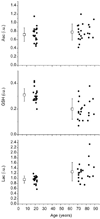Noninvasive quantification of ascorbate and glutathione concentration in the elderly human brain
- PMID: 21834011
- PMCID: PMC3118919
- DOI: 10.1002/nbm.1646
Noninvasive quantification of ascorbate and glutathione concentration in the elderly human brain
Abstract
In this study, ascorbate (Asc) and glutathione (GSH) concentrations were quantified noninvasively using double-edited (1)H MRS at 4 T in the occipital cortex of healthy young [age (mean ± standard deviation) = 20.4 ± 1.4 years] and elderly (age = 76.6 ± 6.1 years) human subjects. Elderly subjects had a lower GSH concentration than younger subjects (p < 0.05). The Asc concentration was not significantly associated with age. Furthermore, the lactate (Lac) concentration was higher in elderly than young subjects. Lower GSH and higher Lac concentrations are indications of defective protection against oxidative damage and impaired mitochondrial respiration. The extent to which the observed concentration differences could be associated with physiological differences and methodological artifacts is discussed. In conclusion, GSH and Asc concentrations were compared noninvasively for the first time in young vs elderly subjects.
Copyright © 2011 John Wiley & Sons, Ltd.
Figures




References
-
- Rice ME, Russo-Menna I. Differential compartmentalization of brain ascorbate and glutathione between neurons and glia. Neuroscience. 1998;82(4):1213–1223. - PubMed
-
- Rice ME, Forman RE, Chen BT, Avshalumov MV, Cragg SJ, Drew KL. Brain antioxidant regulation in mammals and anoxia-tolerant reptiles: balanced for neuroprotection and neuromodulation. Comp. Biochem. Physiol. C: Toxicol. Pharmacol. 2002;133(4):515–525. - PubMed
-
- Hediger MA. New view at C. Nat. Med. 2002;8(5):445–446. - PubMed
-
- Spector R. Nutrient transport systems in brain: 40 years of progress. J. Neurochem. 2009;111(2):315–320. - PubMed
Publication types
MeSH terms
Substances
Grants and funding
LinkOut - more resources
Full Text Sources
Medical
Miscellaneous

